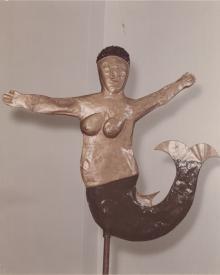- Home
- Archival Material
- College History Projects
- Subject-Based Digital Projects
The Mermaid Story

The Dickinson College mermaid was originally designed as a weathervane to be placed on top of the cupola of Old West. It is believed that the architect of the building, Benjamin Latrobe, intended the weatherwane to be in the form of Triton, in reference to the ancient Temple of the Winds in Athens. The local metalworker who was given the task of crafting the Triton likely had little knowledge of the temple or this mythical male sea god, so he created the closest thing he could imagine - a mermaid. Alumnus and faculty member Charles Francis Himes, class of 1855, first detailed this theory in a pamphlet, printed in the early 20th century.
The mermaid story could not be told without mentioning its long history as a target for college pranksters. In 1915 a group of students from the Alpha Chi Rho fraternity stole the college chaplain’s bicycle, climbed on top of the cupola, and fastened the bike so as to create the image of the mermaid riding it. This is the earliest known prank involving the mermaid. Throughout the 1950s and 1960s, fraternities would often compete to steal the mermaid and “hold her ransom,” eventually returning her to the college president at the Homecoming football game.
This tradition took a different turn in 1967 when the mermaid appeared to have actually been stolen. After several months, the mermaid was found in an apartment in New York. A group of first-year students had abducted her in March, but she was not immediately returned. It turns out that a Dickinson dropout had planned to take the mermaid to Paris to sell it as an art object. When college authorities contacted the former student's parents and mentioned that taking stolen art across state lines constituted a federal crime, the mermaid was quickly returned without incident.
Once the mermaid was safely back in Carlisle, the president decided that it was time for her to be retired to the reading room of the college archives. After a few years, a pedestal was created so that the mermaid could be viewed through the glass doors of the May Morris Room (what is today the East Asian Studies Room) on the second floor of the Spahr Library. At the same time, the president commissioned a replica mermaid, which was merely a two-dimensional outline of the original. This new figure was disliked by students, faculty, and alumni, but attempts to steal it continued nonetheless. Fearing that students might be seriously injured during an attempted theft, the decision was made in the mid-1970s to remove the replica from atop Old West, leaving the top of the cupola bare for several years. In the late 1980s, a more accurate three-dimensional replica was created, and this new mermaid returned to its perch above the cupola, but with added security measures to discourage would-be thieves.
In 2000, the original mermaid was moved from the archives and placed in a carefully-secured display case in the new Waidner-Spahr Library, making her more visible to the entire campus community to admire.
Date of Post:
2017